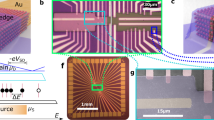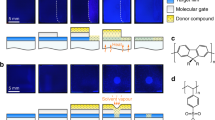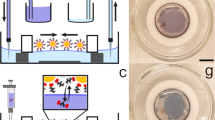Abstract
Recently, by mastering either top-down or bottom-up approaches, tailor-made macromolecular nano-objects with semiconducting properties have been fabricated. These engineered nanostructures for organic electronics are based on conjugated systems predominantly made up of sp2-hybridized carbon, such as graphene nanoribbons. Here, we describe developments in a selection of these nanofabrication techniques, which include graphene carving, stimulus-induced synthesis of conjugated polymers and surface-assisted synthesis. We also assess their potential to reproduce chemically and spatially precise molecular arrangements, that is, molecular blueprints. In a broad context, the engineering of a molecular blueprint represents the fabrication of an integrated all-organic macromolecular electronic circuit. In this Perspective, we suggest chemical routes, as well as convergent on-surface synthesis and microfabrication approaches, for the ultimate goal of bringing the field closer to technology.
This is a preview of subscription content, access via your institution
Access options
Subscribe to this journal
Receive 12 print issues and online access
$259.00 per year
only $21.58 per issue
Buy this article
- Purchase on Springer Link
- Instant access to full article PDF
Prices may be subject to local taxes which are calculated during checkout




Similar content being viewed by others
References
Corey, E. J. Retrosynthetic thinking – essentials and examples. Chem. Soc. Rev. 17, 111–133 (1988).
Brady, P. A. & Sanders, J. K. M. Selection approaches to catalytic systems. Chem. Soc. Rev. 26, 327–336 (1997).
Lehn, J.-M. Supramolecular Chemistry: Concepts and Perspectives (Wiley-VCH, 1995).
Moth-Poulsen, K. & Bjornholm, T. Molecular electronics with single molecules in solid-state devices. Nature Nanotech. 4, 551–556 (2009).
Geim, A. K. Graphene: status and prospects. Science 324, 1530–1534 (2009).
Metzger, R. M. Unimolecular electronics. J. Mater. Chem. 18, 4364–4396 (2008).
Joachim, C,. Gimzewski, J. K. & Aviram, A. Electronics using hybrid-molecular and mono-molecular devices. Nature 408, 541–548 (2000).
Arias, A. C,. MacKenzie, J. D,. McCulloch, I,. Rivnay, J. & Salleo, A. Materials and applications for large area electronics: solution-based approaches. Chem. Rev. 110, 3–24 (2010).
Baughman, R. H,. Zakhidov, A. A. & de Heer, W. A. Carbon nanotubes - the route toward applications. Science 297, 787–792 (2002).
Schwierz, F. Graphene transistors. Nature Nanotech. 5, 487–496 (2010).
Moore, G. E. Cramming more components onto integrated circuits. Proc. IEEE 86, 82–85 (1998).
Xia, F,. Perebeinos, V,. Lin, Y.-M,. Wu, Y. & Avouris, P. The origins and limits of metal-graphene junction resistance. Nature Nanotech. 6, 179–184 (2011).
Novoselov, K. Mind the gap. Nature Mater. 6, 720–721 (2007).
Nakada, K,. Fujita, M,. Dresselhaus, G. & Dresselhaus, M. S. Edge state in graphene ribbons: Nanometer size effect and edge shape dependence. Phys. Rev. B 54, 17954–17961 (1996).
Barone, V,. Hod, O. & Scuseria, G. E. Electronic structure and stability of semiconducting graphene nanoribbons. Nano Lett. 6, 2748–2754 (2006).
Yang, L,. Park, C.-H,. Son, Y.-W,. Cohen, M. L. & Louie, S. G. Quasiparticle energies and band gaps in graphene nanoribbons. Phys. Rev. Lett. 99, 186801 (2007).
Li, X. L,. Wang, X. R,. Zhang, L,. Lee, S. W. & Dai, H. J. Chemically derived, ultrasmooth graphene nanoribbon semiconductors. Science 319, 1229–1232 (2008).
Avouris, P,. Chen, Z. H. & Perebeinos, V. Carbon-based electronics. Nature Nanotech. 2, 605–615 (2007).
Ponomarenko, L. A. et al. Chaotic dirac billiard in graphene quantum dots. Science 320, 356–358 (2008).
Murphy, A. R. & Fréchet,, J. M. J. Organic semiconducting oligomers for use in thin film transistors. Chem. Rev. 107, 1066–1096 (2007).
Braga, D. & Horowitz, G. High-performance organic field-effect transistors. Adv. Mater. 21, 1473–1486 (2009).
Huang, Y. et al. Logic gates and computation from assembled nanowire building blocks. Science 294, 1313–1317 (2001).
Rycerz, A,. Tworzydlo, J. & Beenakker, C. W. J. Valley filter and valley valve in graphene. Nature Phys. 3, 172–175 (2007).
Han, M. Y,. Ozyilmaz, B,. Zhang, Y. B. & Kim, P. Energy band-gap engineering of graphene nanoribbons. Phys. Rev. Lett. 98, 206805 (2007).
Mativetsky, J. M. et al. Local current mapping and patterning of reduced graphene oxide. J. Am. Chem. Soc. 132, 14130–14136 (2010).
Wei, Z. Q. et al. Nanoscale tunable reduction of graphene oxide for graphene electronics. Science 328, 1373–1376 (2010).
Tapasztó, L,. Dobrik, G,. Lambin, P. & Biró, L. P. Tailoring the atomic structure of graphene nanoribbons by scanning tunnelling microscope lithography. Nature Nanotech. 3, 397–401 (2008).
Wang, X. R. & Dai, H. J. Etching and narrowing of graphene from the edges. Nature Chem. 2, 661–665 (2010).
Yang, R. et al. An Anisotropic etching effect in the graphene basal plane. Adv. Mater. 22, 4014–4019 (2010).
Kosynkin, D. V. et al. Longitudinal unzipping of carbon nanotubes to form graphene nanoribbons. Nature 458, 872–876 (2009).
Jiao, L,. Zhang, L,. Wang, X. R,. Diankov, G. & Dai, H. J. Narrow graphene nanoribbons from carbon nanotubes. Nature 458, 877–880 (2009).
Xie, L,. Jiao, L. & Dai, H. J. Selective etching of graphene edges by hydrogen plasma. J. Am. Chem. Soc. 132, 14751–14753 (2010).
Okawa, Y. & Aono, M. Nanoscale control of chain polymerization. Nature 409, 683–684 (2001).
Akai-Kasaya, M. et al. Electronic structure of a polydiacetylene nanowire fabricated on highly ordered pyrolytic graphite. Phys. Rev. Lett. 91, 255501 (2003).
Hla, S.-W,. Bartels, L,. Meyer, G. & Rieder, K.-H. Inducing all steps of a chemical reaction with the scanning tunneling microscope tip: towards single molecule engineering. Phys. Rev. Lett. 85, 2777 (2000).
Fenwick, O. et al. Thermochemical nanopatterning of organic semiconductors. Nature Nanotech. 4, 664–668 (2009).
Campos, L. C,. Manfrinato, V. R,. Sanchez-Yamagishi, J. D,. Kong, J. & Jarillo-Herrero, P. Anisotropic etching and nanoribbon formation in single-layer graphene. Nano Lett. 9, 2600–2604 (2009).
Ciesielski, A,. Palma, C. A,. Bonini, M. & Samorì, P. Towards supramolecular engineering of functional nanomaterials: pre-programming multi-component 2D self-assembly at solid-liquid interfaces. Adv. Mater. 22, 3506–3520 (2010).
Bent, B. E. Mimicking aspects of heterogeneous catalysis: generating, isolating, and reacting proposed surface intermediates on single crystals in vacuum. Chem. Rev. 96, 1361–1390 (1996).
Ma, Z. & Zaera, F. Organic chemistry on solid surfaces. Surf. Sci. Rep. 61, 229–281 (2006).
Masel, R. L. Principles of Adsorption and Reaction on Solid Surfaces (Wiley, 1996).
Cai, J. M. et al. Atomically precise bottom-up fabrication of graphene nanoribbons. Nature 466, 470–473 (2010).
Lipton-Duffin, J. A. et al. Step-by-step growth of epitaxially aligned polythiophene by surface-confined reaction. Proc. Natl. Acad. Sci. USA 107, 11200–11204 (2010).
Szulczewski, G. J. & White, J. M. Thermal and photon-stimulated reactions of iodobenzene on Ag(111). Surf. Sci. 399, 305–315 (1998).
Bieri, M. et al. Porous graphenes: two-dimensional polymer synthesis with atomic precision. Chem. Commun. 6919–6921 (2009).
Lipton-Duffin, J. A,. Ivasenko, O,. Perepichka, D. F. & Rosei, F. Synthesis of polyphenylene molecular wires by surface-confined polymerization. Small 5, 592–597 (2009).
Lafferentz, L. et al. Conductance of a single conjugated polymer as a continuous function of its length. Science 323, 1193–1197 (2009).
Ertl, G. Reactions at Solid Surfaces (Wiley, 2009).
Grill, L. et al. Nano-architectures by covalent assembly of molecular building blocks. Nature Nanotech. 2, 687–691 (2007).
Lu, J,. Yeo, P. S. E,. Gan, C. K,. Wu, P. & Loh, K. P. Transforming C60 molecules into graphene quantum dots. Nature Nanotech. 6, 247–252 (2011).
Bieri, M. et al. Two-dimensional polymer formation on surfaces: insight into the roles of precursor mobility and reactivity. J. Am. Chem. Soc. 132, 16669–16676 (2010).
Shchukin, V. A,. Ledentsov, N. N. & Bimberg, D. Epitaxy of Nanostructures (Springer, 2004).
Gutzler, R. et al. Surface mediated synthesis of 2D covalent organic frameworks: 1,3,5-tris(4-bromophenyl)benzene on graphite(001), Cu(111), and Ag(110). Chem. Commun. 4456–4456 (2009).
Blunt, M. O,. Russell, J. C,. Champness, N. R. & Beton, P. H. Templating molecular adsorption using a covalent organic framework. Chem. Commun. 46, 7157–7159 (2010).
Treier, M. et al. Surface-assisted cyclodehydrogenation provides a synthetic route towards easily processable and chemically tailored nanographenes. Nature Chem. 3, 61–67 (2010).
Ullmann, F. & Bielecki, J. Ueber Synthesen in der Biphenylreihe. Ber. Dtsch. Chem. Ges. 34, 2174–2185 (1901).
Xi, M. & Bent, B. E. Mechanisms of the Ullmann coupling reaction in adsorbed monolayers. J. Am. Chem. Soc. 115, 7426–7433 (1993).
Sakamoto, J,. van Heijst, J,. Lukin, O. & Schlüter, A. D. Two-dimensional polymers: just a dream of synthetic chemists? Angew. Chem. Int. Ed. 48, 1030–1069 (2009).
Bombis, C. et al. Single molecular wires connecting metallic and insulating surface areas. Angew. Chem. Int. Ed. 48, 9966–9970 (2009).
Grzybowski, B. A,. Bishop, K. J. M,. Kowalczyk, B. & Wilmer, C. E. The 'wired' universe of organic chemistry. Nature Chem. 1, 31–36 (2009).
Hod, O,. Barone, V,. Peralta, J. E. & Scuseria, G. E. Enhanced half-metallicity in edge-oxidized zigzag graphene nanoribbons. Nano Lett. 7, 2295–2299 (2007).
Perepichka, D. F. & Rosei, F. Extending polymer conjugation into the second dimension. Science 323, 216–217 (2009).
Geim, A. K. & Novoselov, K. S. The rise of graphene. Nature Mater. 6, 183–191 (2007).
Acknowledgements
We thank Matthias Treier and Veronica Barone for sharing helpful data and for useful discussions. This work was financially supported by the EC Marie-Curie RTNs PRAIRIES (MRTN-CT-2006-035810) and THREADMILL (MRTN-CT-2006-036040) as well as the ITNs SUPERIOR (PITN-GA-2009-238177) and GENIUS (PITN-GA-2010-264694), the EC FP7 ONE-P large-scale project no. 212311, the NanoSci-E+ project SENSORS and the International Center for Frontier Research in Chemistry (FRC, Strasbourg).
Author information
Authors and Affiliations
Corresponding author
Ethics declarations
Competing interests
The authors declare no competing financial interests.
Rights and permissions
About this article
Cite this article
Palma, CA., Samorì, P. Blueprinting macromolecular electronics. Nature Chem 3, 431–436 (2011). https://doi.org/10.1038/nchem.1043
Published:
Issue Date:
DOI: https://doi.org/10.1038/nchem.1043
This article is cited by
-
Self-assembly and photoinduced fabrication of conductive nanographene wires on boron nitride
Nature Communications (2022)
-
Polycyclic aromatic chains on metals and insulating layers by repetitive [3+2] cycloadditions
Nature Communications (2020)
-
Stepwise on-surface dissymmetric reaction to construct binodal organometallic network
Nature Communications (2019)
-
Collective molecular switching in hybrid superlattices for light-modulated two-dimensional electronics
Nature Communications (2018)
-
Interfactant action of an amphiphilic polymer upon directing graphene oxide layer formation on sapphire substrates
Applied Adhesion Science (2017)



